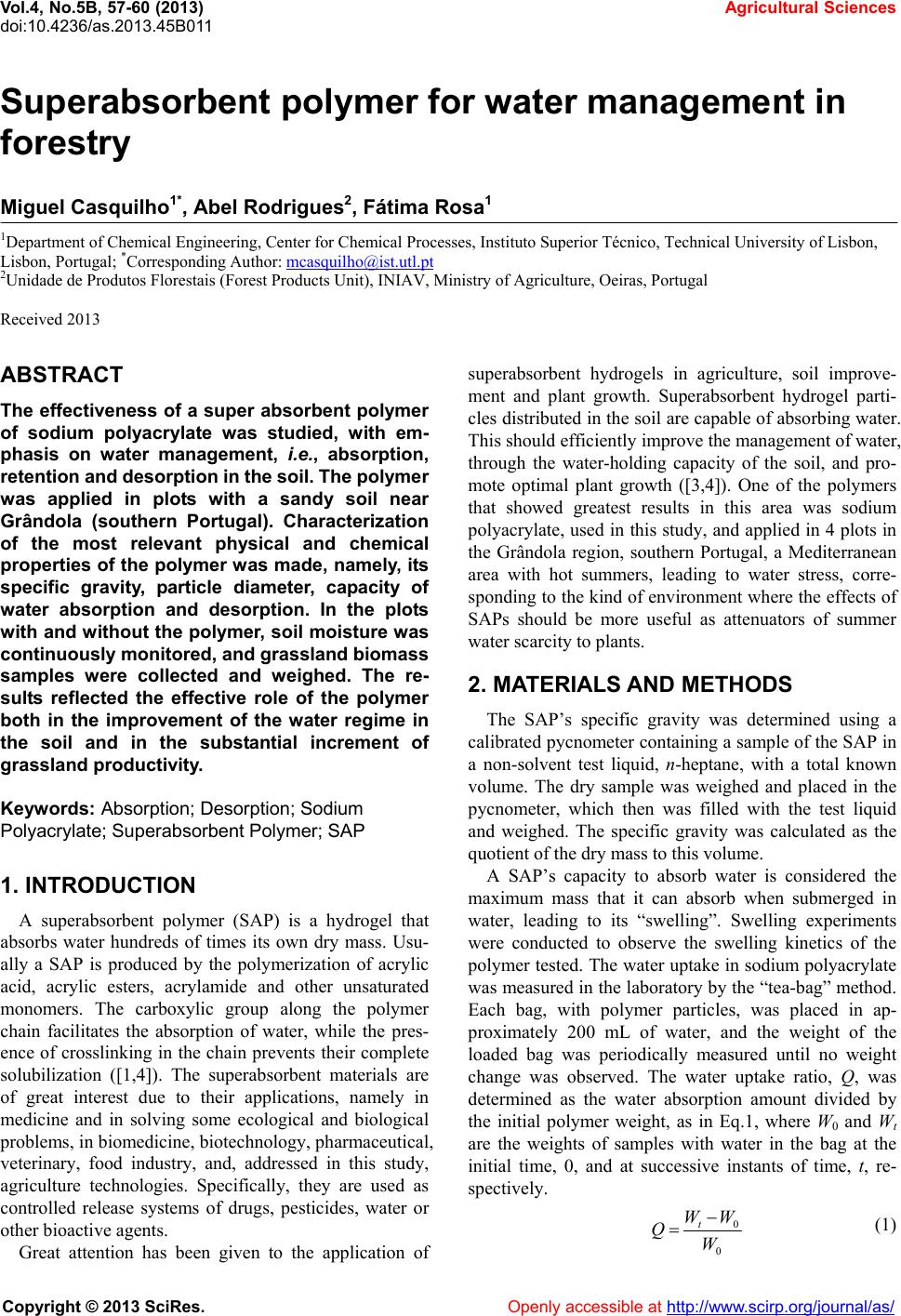
Vol.4, No.5B, 57-60 (2013) Agricultural Sciences
doi:10.4236/as.2013.45B011
Superabsorbent polymer for water management in
forestry
Miguel Casquilho1*, Abel Rodrigues2, Fátima Rosa1
1Department of Chemical Engineering, Center for Chemical Processes, Instituto Superior Técnico, Technical University of Lisbon,
Lisbon, Portugal; *Corresponding Author: mcasquilho@ist.utl.pt
2Unidade de Produtos Florestais (Forest Products Unit), INIAV, Ministry of Agriculture, Oeiras, Portugal
Received 2013
ABSTRACT
The effectiveness of a super absorbent polymer
of sodium polyacrylate was studied, with em-
phasis on water management, i.e., absorption,
retention and desorption in the soil. The polymer
was applied in plots with a sandy soil near
Grândola (southern Portugal). Characterization
of the most relevant physical and chemical
properties of the polymer was made, namely, its
specific gravity, particle diameter, capacity of
water absorption and desorption. In the plots
with and without the polymer, soil moisture was
continuously monitored, and grassland biomass
samples were collected and weighed. The re-
sults reflected the effective role of the polymer
both in the improvement of the water regime in
the soil and in the substantial increment of
grassland productivi ty.
Keywords: Absorption; Desorption; Sodium
Polyacrylate; Superabsorbent Polymer; SAP
1. INTRODUCTION
A superabsorbent polymer (SAP) is a hydrogel that
absorbs water hundreds of times its own dry mass. Usu-
ally a SAP is produced by the polymerization of acrylic
acid, acrylic esters, acrylamide and other unsaturated
monomers. The carboxylic group along the polymer
chain facilitates the absorption of water, while the pres-
ence of crosslinking in the chain prevents their complete
solubilization ([1,4]). The superabsorbent materials are
of great interest due to their applications, namely in
medicine and in solving some ecological and biological
problems, in biomedicine, biotechnology, pharmaceutical,
veterinary, food industry, and, addressed in this study,
agriculture technologies. Specifically, they are used as
controlled release systems of drugs, pesticides, water or
other bioacti ve age nt s.
Great attention has been given to the application of
superabsorbent hydrogels in agriculture, soil improve-
ment and plant growth. Superabsorbent hydrogel parti-
cles distributed in the soil are capab le of absorbing water.
This should efficiently improve the managemen t of water,
through the water-holding capacity of the soil, and pro-
mote optimal plant growth ([3,4]). One of the polymers
that showed greatest results in this area was sodium
polyacrylate, used in this study, and applied in 4 plo ts in
the Grândola region, southern Portugal, a Mediterranean
area with hot summers, leading to water stress, corre-
sponding to the kind of environment where the effects of
SAPs should be more useful as attenuators of summer
water scarcity to plants.
2. MATERIALS AND METHODS
The SAP’s specific gravity was determined using a
calibrated pycnometer containing a sample of the SAP in
a non-solvent test liquid, n-heptane, with a total known
volume. The dry sample was weighed and placed in the
pycnometer, which then was filled with the test liquid
and weighed. The specific gravity was calculated as the
quotient of the dry mass to this volume.
A SAP’s capacity to absorb water is considered the
maximum mass that it can absorb when submerged in
water, leading to its “swelling”. Swelling experiments
were conducted to observe the swelling kinetics of the
polymer tested. The water uptake in sodium polyacrylate
was measured in the laboratory by the “tea-bag” method.
Each bag, with polymer particles, was placed in ap-
proximately 200 mL of water, and the weight of the
loaded bag was periodically measured until no weight
change was observed. The water uptake ratio, Q, was
determined as the water absorption amount divided by
the initial polymer weight, as in Eq.1, where W0 and Wt
are the weights of samples with water in the bag at the
initial time, 0, and at successive instants of time, t, re-
spectively.
0
0
W
WW
Qt
(1)
Copyright © 2013 SciRes. Openly accessible at http://www.scirp.org/journal/as/